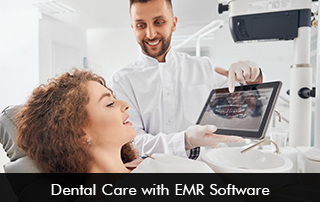These days, in the hustle and bustle of dental practices, Electronic Medical Records (EMR) Software is revolutionizing the way dentists look after their patients. EMR Software makes things easier by streamlining paperwork and boosting communication, becoming a must-have for providing top-notch, well-organized, and tailored dental care. The fact that more and more practices are using it shows a bigger shift in healthcare across the U.S., where digital tools are helping healthcare providers give better care.
Streamlining Clinical Workflows for Dentists with EMR Software
Dentistry EMR Software acts as a central hub, bringing together all crucial patient data like medical history, allergies, x-ray images, treatment plans, and billing information into one easily navigable system. This consolidation means dentists can spend less time on paperwork, move away from cumbersome paper charts, and quickly look up past treatments or diagnoses. Many of these EMR Systems options also come with handy features like voice recognition for taking clinical notes and customizable dental charts, which can free up more time for dentists to focus on their patients and improve accuracy.
The American Dental Association (ADA) is on board with using digital health records, emphasizing their role in ensuring seamless care and patient safety in the field of dentistry, particularly when dealing with chronic conditions tied to oral health, such as diabetes or heart disease (ADA, 2023).
EHR Software Leads to Better Patient Engagement for Dental Patients
Modern dental patients value clear information and easy access. Dental practices can meet these expectations by using EMR Software that includes patient portals and robust patient engagement tools. These portals offer secure messaging, online appointment scheduling, and access to treatment plans and invoices. By providing these tools, patients are more engaged and take a more active role in their dental care. The Centers for Disease Control and Prevention (CDC) highlights the importance of patient education and regular preventive care in maintaining good oral health (CDC, 2024).
Additionally, EMR Software Systems can automate reminders for routine checkups, cleanings, and follow-up appointments, leading to improved patient compliance and earlier identification of any oral health problems.
Data-Driven Decisions with EMR Software
Dental EHR software frequently features analytics dashboards that assist providers in recognizing trends in patient actions, pinpointing prevalent diagnoses, and overseeing treatment results. This method, grounded in data, fosters evidence-based dental practices, leading to more accurate and knowledgeable care choices. As AI instruments are being introduced into EMR Systems, dentists can now foresee risks such as tooth decay or gum disease before they escalate, ultimately enhancing patient outcomes.
Moving Ahead
Dental care is changing, and Electronic Medical Records Software is at the heart of this transformation. It’s making a big difference in how dental practices run day-to-day, how dentists make clinical decisions, and how they communicate with patients.
Across the United States, dental offices are using EMR Software to provide care that’s up-to-date, efficient, and puts the patient first. As we increasingly understand how dental health connects to our overall health, having a strong EHR Software is essential for dental practices and to keep patients satisfied.








